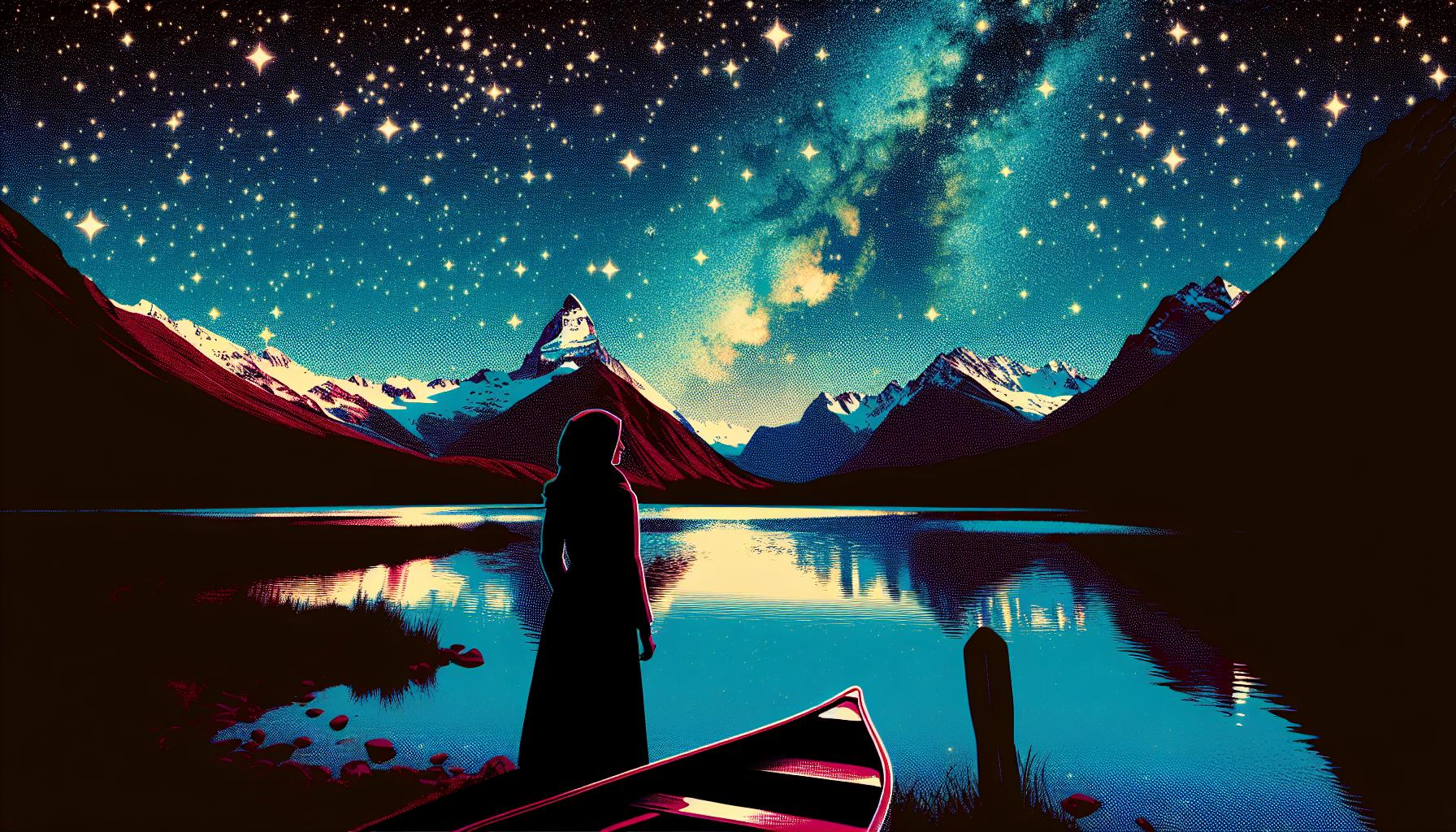This site contains affiliate links to products. I may receive a commission for purchases made through these links.
If you’re like me, there’s nothing quite like looking up at the night sky, awestruck by the sheer beauty of the cosmos. Now, imagine doing this in a place recognized as an International Dark Sky Reserve. That’s right, I’m talking about New Zealand.
This country, known for its stunning landscapes, is also a haven for stargazers. With minimal light pollution and clear skies, it’s one of the best places on Earth to witness the majesty of the universe.
From the Southern Alps to the remote Stewart Island, New Zealand offers an array of locations perfect for stargazing. So, whether you’re an astronomy enthusiast or just someone who appreciates a starlit sky, this guide is for you. Let’s explore the top stargazing spots in New Zealand together.
Stargazing Locations in New Zealand
New Zealand’s natural beauty extends beyond the daytime landscape; when the sun sets, a new world opens up onto the night sky. Watching the staggering amount of stars is an unforgettable experience that tugs at your soul. I’ll walk you through the prime stargazing spots in this galaxy-friendly country.
The Aoraki Mackenzie Dark Sky Reserve needs to top your list. Renowned globally, it’s the only Dark Sky Reserve in the Southern Hemisphere. The lack of light pollution here makes the Milky Way more visible than almost anywhere on earth.
Over at the Lake Tekapo, you’d experience the universe from Mt John Observatory. It’s another crucial addition to your must-visit list. The observatory houses some of the most advanced astronomical research equipment, providing better insight into our universe’s intricacies.
Located at the southernmost part of New Zealand, Rakiura National Park in Stewart Island is particularly famous for spotting the Aurora Australis. It’s one of the few places where you can see the Southern Lights spread out against the background of a star-spangled sky.
Lastly, the Southern Alps, runs down the length of the South Island, serves as a perfect backdrop for stargazing. The high altitude and distant location from city lights make it one of the premium stargazing spots.
These places offer the sheer joy of observing celestial bodies in their full glory. However, remember that each location presents a unique way to experience the cosmos. I recommend it’s essential to take time to appreciate the differences in what each site offers, making your stargazing journey all the more memorable.
International Dark Sky Reserves in New Zealand
In recent years, I’ve seen an increasing interest in one particularly exceptional feature that makes New Zealand unique – our Dark Sky Reserves. Arguably, New Zealand holds some of the world’s best stargazing spots. Places so pristine and untouched by light pollution that they’ve earned an international reputation by being certified as International Dark Sky Reserves.
Probably the jewel in New Zealand’s stargazing crown is the Aoraki Mackenzie Dark Sky Reserve. It’s the only Dark Sky Reserve in the southern hemisphere offering spellbinding views of the Milky Way. This spans a 4300 square kilometer area covering Aoraki Mt. Cook National Park and the Mackenzie Basin. Stepping into this Dark Sky Reserve, you’ll feel as though you’ve walked straight into a star-speckled dream.
Additionally, on the outskirts of this Reserve is the Mount John Observatory in Lake Tekapo. Technically, it’s not a Dark Sky Reserve. But given its location surrounded by mountains and its high altitude, it’s practically light pollution-free and offers a celestial viewing experience that’s second to none. At this Observatory, you’re not just looking at stars with your naked eyes. You’re given access to some cutting-edge astronomical research equipment, making the distant stars feel within your reach.
New Zealand’s imaginary line called the 45th Parallel South, a halfway point between the equator and South Pole, takes you to some of the best dark sky spaces in the country. Areas around this latitude like Central Otago and the Southern Alps offer uniquely visible sky scenes and are well worth a visit.
There’s also another Dark Sky Reserve in making on Stewart Island. With over 85% of the land designated as Rakiura National Park, it’s a spot known for its unmarred views of the Aurora Australis. However, the move to make this an official Dark Sky Reserve is still in progress and just adds more reasons to visit this picturesque location.
While each of these locations offers distinct experiences, they all share one thing: an untouched view of the universe, that’s hard to match.
Southern Alps: A Stargazer’s Paradise
Nestled beneath the star-studded canvas of the New Zealand sky, the Southern Alps have long deserved their title as a Stargazer’s Paradise. Stretching over 500 kilometers, these majestic mountains provide an unparalleled display of astronomical wonder. It’s as if gazing upwards from these towering peaks gives one the ability to brush the Milky Way with the tips of their fingers.
You may ask, “What makes the Southern Alps special for stargazing?” Well, here’s the answer. High altitude coupled with minimal light pollution enables these peaks to serve as the ideal backdrop for star observers. Think of it like this – higher up means fewer obstructions obstructing the cosmic panorama that’s up for grabs every night.
What’s more, the Southern Alps offer more than just a stunning celestial display. They’re also home to multiple destinations like the Mount Cook Village. Here, the lack of street lights ensures an unspoiled view of the night sky. The Aoraki Mackenzie Dark Sky Reserve further enhances this location, making it an absolute must-visit for stargazers.
For those seeking an interactive experience, the Hermitage Hotel provides stargazing tours led by expert astronomers. Starlit canoe trips across Lake Tekapo and guided walks through star-speckled paths at night also contribute to the full experience this location offers to its visitors.
In addition, the Southern Alps don the Milky Way incredibly well during winters. Starting from late-April to September, the dark, clear nights make the stars appear brighter and more profound. The icing on the cake? This region often receives beautiful displays of auroras, further boosting its appeal to amateur and professional stargazers alike.
Remember, the Southern Alps are home to some of the darkest skies on Earth, serving as a reminder of the beauty that exists when we just look up. As its unofficial nickname suggests, it truly is a ‘Stargazer’s Paradise’. Lovers of the celestial will undoubtedly find this location a perfect retreat to gaze, ponder and appreciate the beauty of the Universe.
Stewart Island: A Secluded Haven for Stargazers
Tucked away at the bottom of the world, Stewart Island offers an unparalleled stargazing experience. with relatively untouched landscapes, it boasts one of the purest dark skies globally, a feature unparalleled in many other places.
Steward Island, or Rakiura in the native Maori language, is the third-largest island in New Zealand. With just one small village and 85 percent of the island declared as a National Park, human-made light pollution is virtually non-existent. The lack of artificial light makes the island a perfect getaway for astronomy enthusiasts.
Rakiura National Park, right at the heart of the island, offers a blanket of darkness that’s ideal for observing the Milky Way and other celestial bodies. Star clusters, galaxies, and even the elusive Aurora Australis are more visible here due to the park’s remote location and clear southern skies.
During the day the island offers hikes and stunning wildlife including the kiwi bird, making it a perfect haven not just for night sky enthusiasts but also for nature lovers. The tranquil and untouched landscapes of Stewart Island provide the perfect backdrop for a night under the stars.
Astrophotographers will find the island’s night skies a paradise for capturing stunning images. The complete absence of artificial lights combined with the island’s unique topography gives the night sky a depth and clarity that’s hard to find elsewhere.
The Stewart Island Ferry Services offers regular trips to and from the island. Accessible by a one-hour ferry ride from Bluff in mainland New Zealand it is easy for travelers to reach this dark sky sanctuary.
The minimal light disturbance, clear southern skies, and untouched landscapes make Stewart Island an exclusive stargazing locale that’s hard to beat. “Starlight, star bright” takes an entirely new connotation against the backdrop of Stewart Island’s captivating pitch-dark skies. I hope you get to see for yourselves, the beauty that Stewart Island holds. It’s one of those unique experiences that represents the raw beauty our world has to offer.
Conclusion
So there you have it. New Zealand’s Southern Alps and Stewart Island are truly out of this world when it comes to stargazing. Whether you’re an amateur astronomer or a seasoned astrophotographer, these spots offer an unparalleled view of the cosmos. The Southern Alps, with its dark sky reserve and stunning mountainous backdrop, provide a unique stargazing experience.
On the other hand, Stewart Island’s untouched landscapes and clear southern skies make it a secluded haven for stargazers. It’s worth taking the ferry ride from Bluff to immerse yourself in the pitch-dark skies of Stewart Island.
These locations are not just about viewing stars; they’re about immersing yourself in the beauty of the universe. So next time you’re planning a stargazing trip, remember to put New Zealand at the top of your list. You won’t be disappointed.



